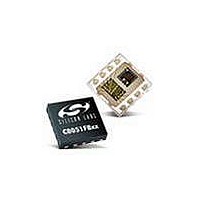Si1120-A-GM Silicon Laboratories Inc, Si1120-A-GM Datasheet - Page 15

Si1120-A-GM
Manufacturer Part Number
Si1120-A-GM
Description
Industrial Optical Sensors Proximity/Ambient Light Snsr w/PWM Out
Manufacturer
Silicon Laboratories Inc
Type
Ambient Light Sensor with Analog Outputr
Datasheet
1.SI1120-A-GM.pdf
(20 pages)
Specifications of Si1120-A-GM
Product
Integrated Ambient Light and Proximity Sensor
Output Type
Analog - Voltage
Maximum Operating Temperature
+ 85 C
Minimum Operating Temperature
- 40 C
Lead Free Status / RoHS Status
Lead free / RoHS Compliant
Available stocks
Company
Part Number
Manufacturer
Quantity
Price
Part Number:
Si1120-A-GMR
Manufacturer:
SILICON LABS/èٹ¯ç§‘
Quantity:
20 000
Si1120
2.7. Practical Considerations
It is important to have an optical barrier between the LED and the Si1120. The reflection from objects to be
detected can be very weak since, for small objects within the LED's emission angle, the amplitude of the reflected
signal decreases in proportion with the fourth power of the distance. The receiver can detect a signal with an
2
irradiance of 1 µW/cm
. An efficient LED typically can drive to a radiant intensity of 100 mW/sr. Hypothetically, if
2
this LED were to couple its light directly into the receiver, the receiver would be unable to detect any 1 µW/cm
2
2
signal since the 100 mW/cm
leakage would saturate the receiver. Therefore, to detect the 1 µW/cm
signal, the
internal optical coupling (e.g. internal reflection) from the LED to the receiver must be minimized to the same order
5
of magnitude (decrease by 10
) as the signal the receiver is attempting to detect. As it is also possible for some
LEDs to drive a radiant intensity of 400 mW/sr, it is good practice to optically decouple the LED from the source by
6
a factor of 10
. A Dual-Port Optical Window shown in Figure 16 can accomplish this easily.
If an existing enclosure is being reused and does not have dedicated openings for the LED and the Si1120, the
proximity detector may still work if the optical loss factor through improvised windows (e.g. nearby microphone or
fan holes) or semi-opaque material is not more than 90% in each direction. In addition, the internal reflection from
an encased device's PMMA (acrylic glass) window (common in cellular telephones, PDAs, etc.) must be reduced
through careful component placement. To reduce the optical coupling from the LED to the Si1120 receiver, the
distance between the LED and the Si1120 should be maximized, and the distance between both components (LED
and Si1120) to the PMMA window should be minimized. The PRX50H mode can be used for the Single-Port
Optical Window shown in Figure 16.
Another practical consideration is that system optical leakage, overlay thickness and transmittance, LED efficiency
variation, TXO sink drive and photodiode part-to-part difference all collectively lead to reflectance measurement
variation even under a given proximity condition. For applications requiring PRX pulse width consistency across
multiple systems, factory calibration is recommended. Factory calibration involves taking a reference measurement
against a consistent and reproducible reflective object (such as an 18% gray card) at a fixed distance during
system production testing. Having this reference proximity measurement stored in non-volatile RAM or Flash
allows host software to make necessary adjustments to incoming PRX pulse widths against this reference
proximity measurement. A low background infrared environment is recommended.
For best proximity range performance, the system optical leakage can be characterized during factory calibration.
To do this, a reference proximity measurement is made when it is known that no object is in proximity of the system
at the time of the measurement. The 'no object' reference measurement allows host software to establish the level
of system optical leakage and make the necessary corrections to account for this.
In a similar way, for applications with heavy reliance on ALS accuracy, measurements using reference light sources
during factory calibration can be used to make adjustments to VAMB, VIRL, and VIRH measurements.
Transparent
window
PRX50H Mode
Si1120
Si1120
Transmit LED
Transmit LED
Optical block
Internal Reflection
Optical block
Single-port Optical Window
Dual-port Optical Window
Figure 16. Dual-Port and Single-Port Optical Window
Rev. 1.0
15











